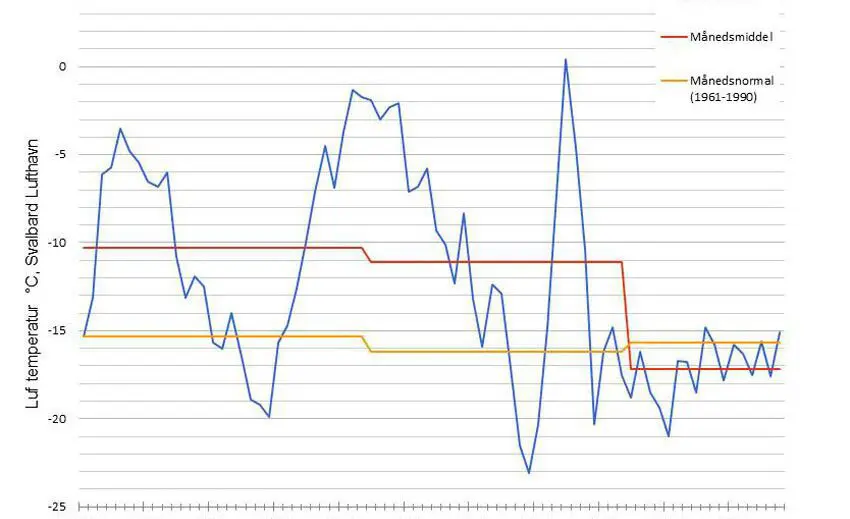Cold, but not cold enough!

Top image: Air temperatures at Svalbard airport from 1 January to 16 March 2019 presented as daily average temperature (blue) and monthly average (red) against normal monthly average (based on measurements in the period 1961-1990).
The frost smoke has been hovering above Adventfjorden the past few weeks, but still the fjord is without an ice cover. So what is the sea temperature now?
22 March 2019
Text: Researchers Janne E. Søreide, Ragnheid Skogseth, Anna Vader and Tove M. Gabrielsen, UNIS and meteorologist Ine-Therese Pedersen, Svalbard weather service office
This Svalbard winter has been cold, but still the mean air temperature in January and February has been above normal, which has been the case for 99 consecutive months (Figure 1). March has started cold and is so far below the monthly standard, but there is still many days left of the month. The frost smoke has been hovering above Adventfjorden, but still the fjord is without an ice cover. So what is the sea temperature now? Some sea ice has formed in the sheltered bays and coves, so it is clear that the fjord has become colder since the last time we were out on February 12. UNIS is out every month and collects hydrographic (temperature and salinity) and biological data from Adventfjorden (IsA – Isfjorden Adventfjorden time series station), a sampling series we have maintained since December 2011.
This year’s marine biology students at UNIS were tasked with checking the sea temperature and the biological condition in the fjord last Wednesday when we were out with Polarsyssel . In January, we reported sea temperatures around + 1.5 ° C in the surface of Adventfjorden. One month later, the surface temperature had fallen to + 0.4 ° C, and last week the surface temperature fell further to -0.6 ° C. Seawater freezes first at -1.8 ° C with the salinity we have in Adventfjorden and the fjords in general in Svalbard, so there is still some uncertainty whether Adventfjorden will freeze this winter.

Further out in the deeper part of Isfjorden (IsK – Karlskronadjupet), there were plus temperatures throughout the whole water column in January. Last week, the temperatures were on the minus side in the entire water column (figure 2), which indicates that new supply of warmer Atlantic water has not penetrated into Isfjorden so far this year. But as mentioned, there is still a long way to go before the fjord reaches freezing temperatures down to -1.8 ° C. Even with air temperatures down to -15 ° C for the rest of the month of March, Isfjorden will not freeze. There may be more ice in the shallow threshold fjords Tempelfjorden, Billefjorden and Dicksonfjorden, but Isfjorden will lie just outside as a large heat reservoir that can affect the side fjords during weather changes.
An increase in the air temperature can quickly change the ice situation to the worse. We remember this well from the winter of 2017, which was relatively cold and where the ice conditions were relatively good. When a low pressure system appeared in April and the air temperatures rose quite substantially, the ice conditions changed rapidly from one day to the next. The sea ice melted both from above and especially from the underside, which resulted, among other things, in the tragic scooter accident Tempelfjorden, where a guide lost his life. So beware of weather changes and do not rely on previous snowmobile tracks when driving on the sea ice.
Finally, a happy message: in Adventfjorden, the production of small microscopic algae (phytoplankton) has started. So spring is definitely approaching. Spring always starts earlier in the sea than on land.
